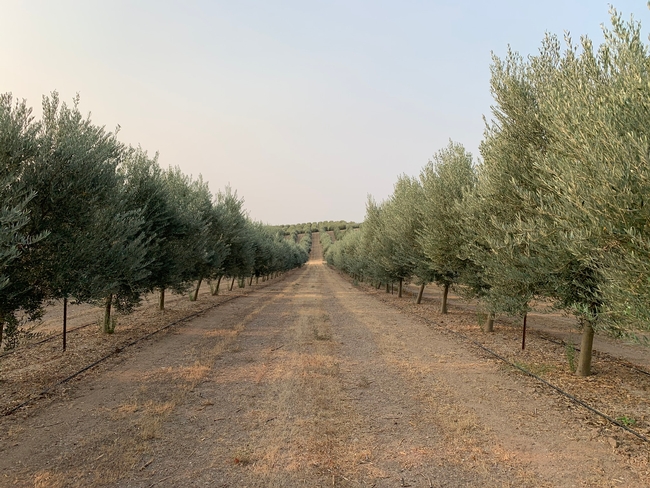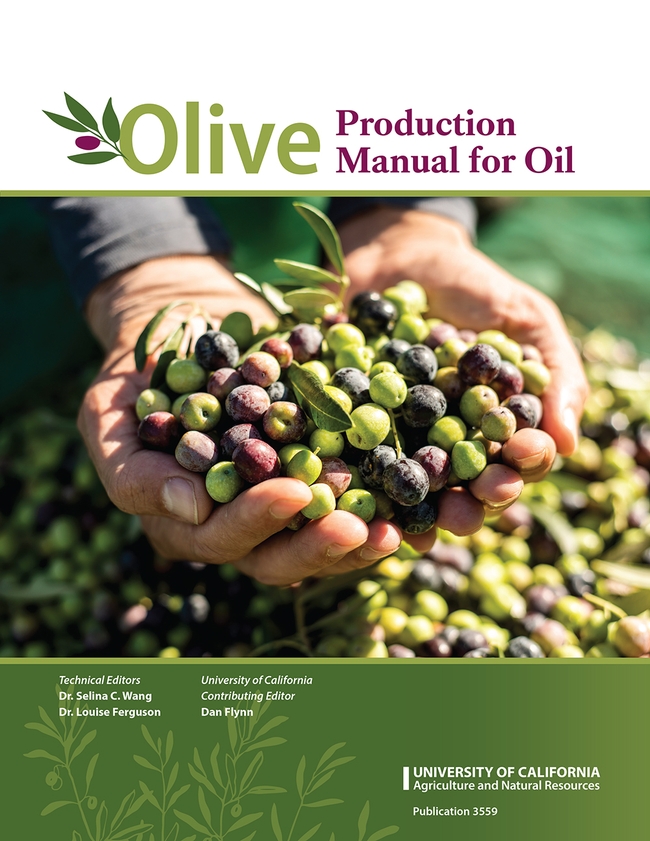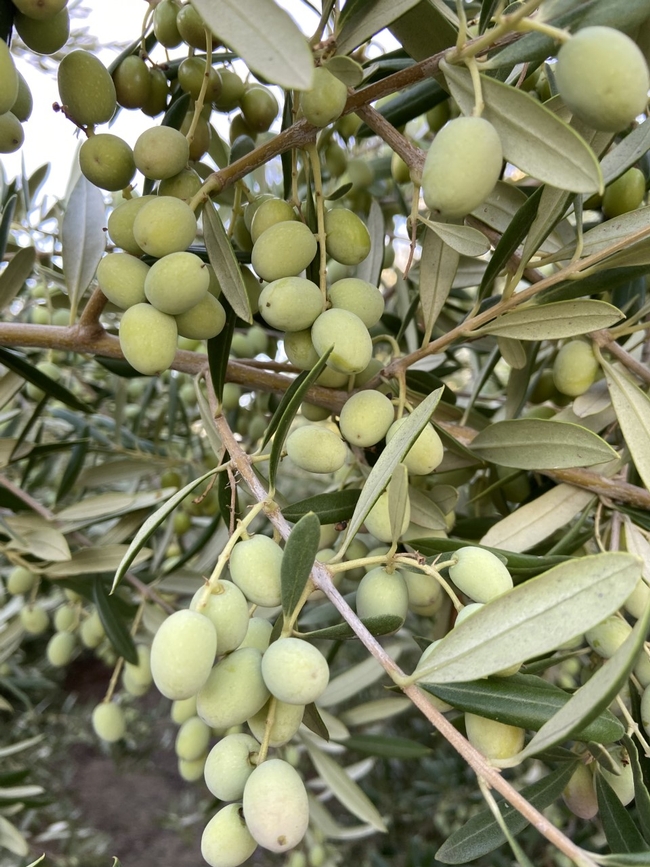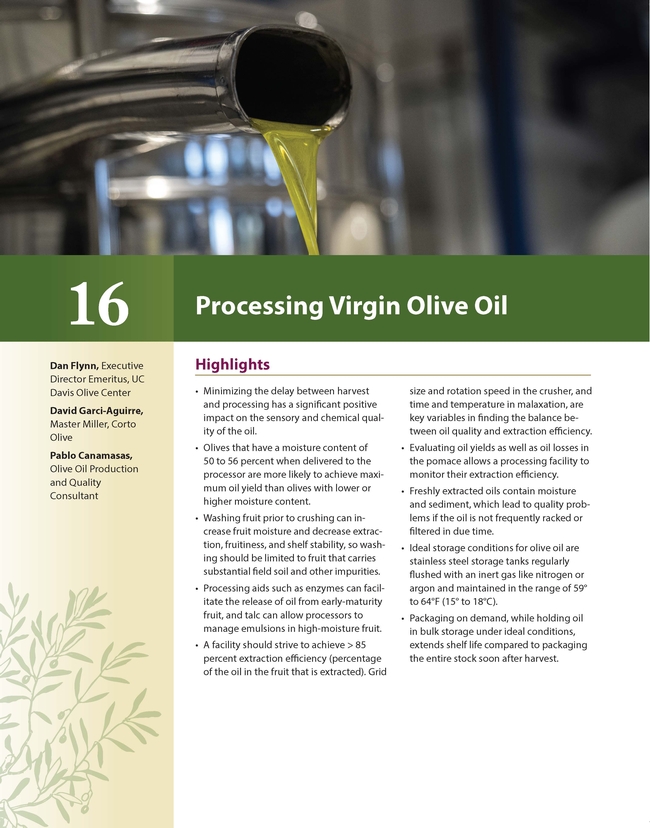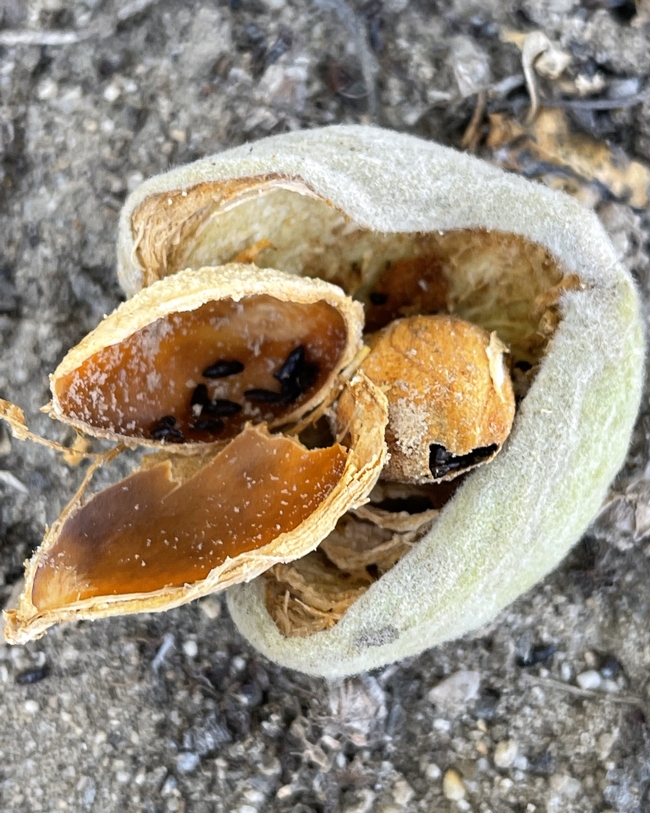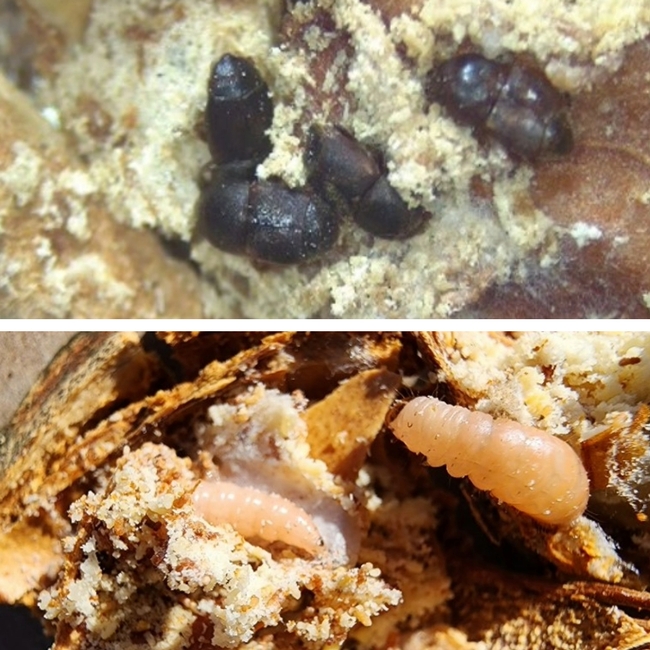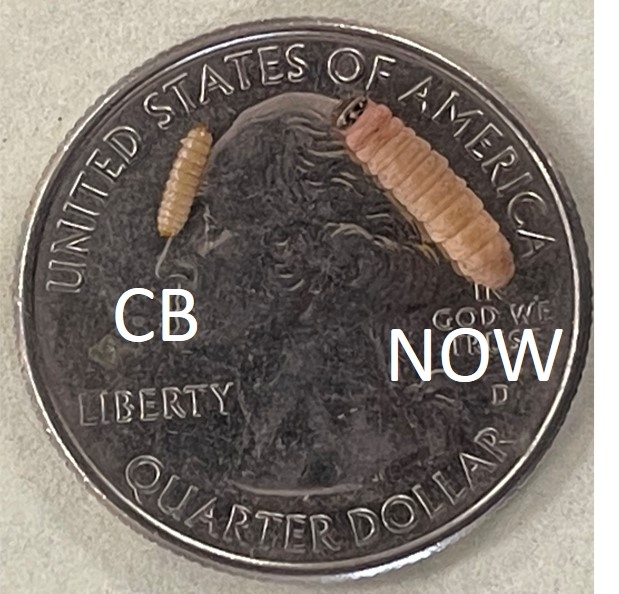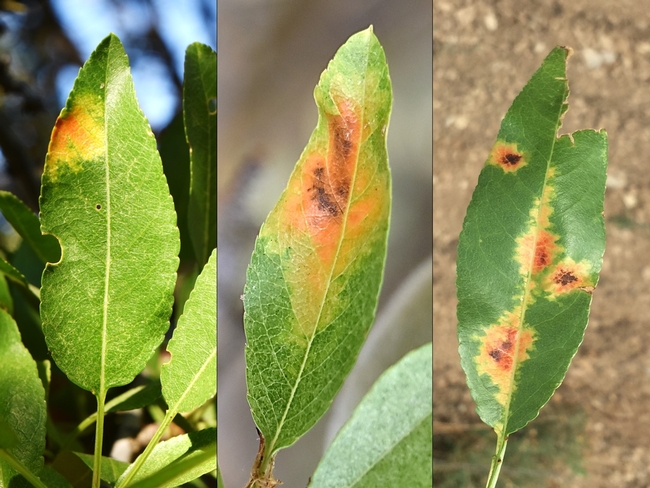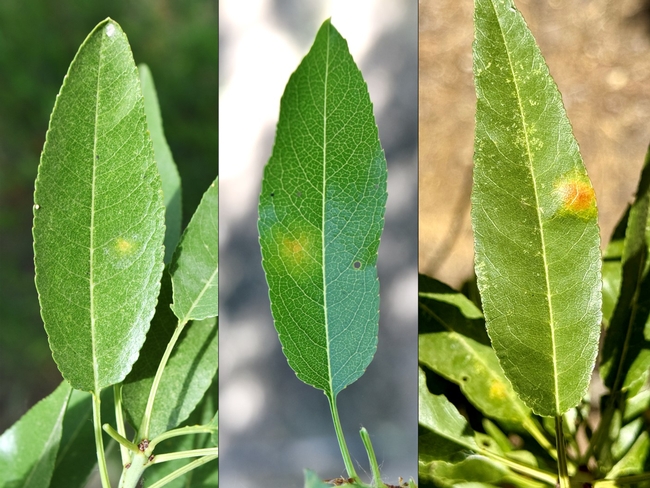Posts Tagged: pest
UC ANR publishes first-ever manual on olive production for oil
Growers, UC Cooperative Extension researchers offer guidance on producing high-quality olives
Facing a deluge of lower-price products from Europe, the California olive oil industry is doubling down on its clear-cut competitive edge: the consistent and bona fide quality of its oil.
“Olive Production Manual for Oil,” a new book published by University of California Agriculture and Natural Resources, aims to help California olive growers maximize that advantage.
“It's a tough market to compete in, but I think the way to win for California is to compete on quality,” said book co-editor Selina Wang, a UC Cooperative Extension specialist in the UC Davis Department of Food Science and Technology. “The quality of California olive oil is unmatched, but you can't make good quality olive oil with bad fruit, so the goal is to get more fruit from the trees – and for the fruits to be high-quality fruit.”
The 273-page manual, available for purchase online, is the first of its kind in the U.S. While some parts of the book are specific to California (which grows nearly all of the olives for domestically produced olive oil), most of the material would be useful to producers in other states, Wang noted.
“Through our conversations with growers, it became clear to us that a manual like this – not a scientific publication but a manual that is easy to follow, written in language that is accessible, and with pictures and illustrations – would be really helpful to the growers,” she said.
Growth of California olive oil industry necessitated creation of manual
Aside from a book focused predominantly on table olives and another on organic olive production (by UCCE farm advisor emeritus Paul Vossen), there was no one-stop, comprehensive resource on the bookshelf for oil olive growers. The need for such a manual had become more acute as oil olives replaced table olives in California orchards during the last 20 years.
Whereas harvesting by hand was historically cost-prohibitive, the introduction of super-high-density planting systems in 1999 made oil olive production more economically feasible. Mechanical pruning and harvesting of new cultivars (Arbequina, Arbosana and Koroneiki) – specifically bred for these densely planted orchards – led to the rapid expansion of oil olives in the state. According to a U.S. Department of Agriculture report, California olive oil production jumped from 2 million pounds in 2006 to an average of 21 million pounds in 2021–23.
With about 37,000 acres of oil olives planted across California, the Olive Oil Commission of California saw the need to support the production of this manual. Championed by Dan Flynn, founder and executive director emeritus of the UC Davis Olive Center, Wang and co-editor Louise Ferguson outlined the contents of the book. They then sought out a mix of growers and industry professionals and UCCE advisors and specialists to write its chapters.
“Most of the information is data-based, from people who are working with the olives,” said Ferguson, a UC Cooperative Extension pomologist at UC Davis. “This is the first data-based olive oil production manual we've had.”
Manual infused with firsthand insights, practical recommendations
Hard-earned experience taught growers a valuable lesson that is conveyed in the book – the need to hand-prune. While mechanical pruning helps control the size of the trees, some hand-pruning is still required to allow light to filter to the leaves. Failing to do so leads to a dramatic decrease in yield.
“That happened in many of the orchards that were inexperienced in these new cultivars and new super-high-density planting systems,” Ferguson said.
She added that other key topics in the manual include irrigation management in a water-constrained state, nitrogen management, harvest timing and orchard site selection. Choosing a good spot for planting is crucial in this era of extreme climate volatility, Ferguson noted, as olive trees are significantly affected by temperature shocks in spring (fruit set) and fall (harvest).
For Wang, another overarching theme in the manual is the importance of testing. Testing the soil, water and leaves provides critical data that growers can use to adjust their inputs and production practices for optimal profitability.
“You may spend a couple hundred dollars on the lab work, but it will pay off, for sure – you're going to increase the health and productivity of your trees,” Wang explained. “Oil olive growers are paid based on the oil content in their fruit; you not only want to have a lot of fruit on the trees, you want to make sure that your fruit are accumulating oil.”
California oil olive growers, practices continue to evolve
Wang and Ferguson hope their book will help California producers compete more effectively in the global marketplace. Currently, about 90% of the olive oil consumed in the U.S. is imported from Mediterranean countries, due primarily to the lower price point. In that region, producers tend to harvest riper olives that produce oil at a greater volume but lesser quality.
In contrast, California growers harvest earlier and produce oil that is higher quality (with more flavor and more antioxidants) and far exceeds accepted standards for “extra virgin olive oil.”
According to Wang, California olive oil mills have nearly maximized their efficiency, and the growth opportunity for the industry is in the orchards: to optimize practices to produce more fruit, and to plant more trees. Wang said the new manual can help on both fronts.
“Just like for other crops, focusing on quality – while increasing efficiency and productivity, and therefore profitability – is the name of the game,” she said.
Ferguson also stressed that knowledge continues to evolve and urged growers to reach out to the editors and chapter authors with their experiences.
“Most of the authors are in California and they're working,” she said. “So if you start to notice things that are different, or you want more information or something is not clear, the authors are available.”
The manual can be purchased at https://anrcatalog.ucanr.edu/Details.aspx?itemNo=3559.
Visual ID guide from UC aids in managing new almond pest
Nut orchard hygiene key to control carpophilus beetle, say UCCE, UC Integrated Pest Management experts
Since the first reports of a new almond pest – the carpophilus beetle (Carpophilus truncatus) – came in during fall 2023, it has become clear that the beetle is widely dispersed across the San Joaquin Valley.
“My lab has identified infestations from every county in the San Joaquin Valley; we have found infestations in both almonds and pistachios, and we will likely find infestations in walnuts this fall,” said Houston Wilson, a University of California Cooperative Extension entomology specialist at UC Riverside. The California Department of Food and Agriculture has confirmed the beetle's presence in Stanislaus, Merced, Madera and Kings counties.
Historically a major threat to almond production in Australia, the beetle – as larvae and adults – feeds directly on the nut kernel. In California, some almond growers have lost 10 to 15% of their yield – a “significant economic loss,” according to Jhalendra Rijal, University of California integrated pest management (IPM) advisor for the region. Given the prominence of almonds as a commodity, even a 1% overall reduction statewide represents an approximately $70 million loss.
“This year there has been a lot more reports from PCAs [pest control advisers]; they're sending me the pictures of the damage and beetles,” said Rijal, noting that the increase is likely due to greater awareness of the pest.
To help almond growers identify the carpophilus beetle and develop management plans, Rijal, Wilson and their IPM colleagues have put together a visual ID guide for the beetle and the damage it causes, as well as telltale signs of navel orangeworm (Amyelois transitella) and ant damage. In particular, the experts would like PCAs and growers to differentiate between the carpophilus beetle and navel orangeworm, another key pest in almonds.
“Even though their way of causing damage looks more or less similar, we're dealing with two different types of insects,” Rijal explained. “One is a Lepidoptera moth [navel orangeworm], and the other one is a beetle – many of the management practices and biological controls would be different for these two different things.”
To control carpophilus beetle, ‘sanitize, sanitize, sanitize'
One crucial cultural practice for managing both pests, however, is destroying the remnant “mummy” nuts – the nuts that remain in the orchard postharvest. They serve as overwintering habitat for the carpophilus beetle, as well as its sustenance for the next generation of beetles in spring.
“The best way to manage this pest is to do the orchard hygiene – continuing the winter sanitation, destroying the nuts that are on the ground and on the tree and on the berms,” Rijal said.
Based on observations in Australia and locally, carpophilus beetles tend to rely more on mummies on the ground, whereas navel orangeworm generally favors mummies in the tree canopy. Correctly identifying the pest – with help from the new ID guide – enables growers to better target and prioritize their management efforts, Rijal said.
“What we are strongly emphasizing is that growers need to sanitize, sanitize, sanitize to control both pests,” Wilson added.
Correct identification of the pest would also prevent unnecessary application of insecticides, as those used for controlling Lepidoptera such as navel orangeworm would be largely ineffective on the beetle.
Indeed, another insight shared by Australian experts is that the carpophilus beetle cannot be controlled just by insecticide.
“Insecticides are not very efficient, given the cryptic nature of these beetles; exposing these beetles to the insecticide is very hard,” said Rijal, noting that the beetle spends most of its life cycle protected inside the nut.
Reporting carpophilus beetle infestation helps researchers
This harvest season, Rijal advises almond growers to harvest as efficiently as possible, to minimize the number of mummies that need to be cleaned up. And because signs of damage (like damaged hulls and frass) are most obvious during harvest time, Rijal said growers should review the new guide, using the photos and other resources to help identify potential pests.
If the grower or PCA suspects a carpophilus beetle infestation, they should contact the UCCE farm advisor in their area.
Scientists are looking to expand their knowledge about this relatively new pest to California. In the coming weeks, for example, researchers are planning to survey for the carpophilus beetle in the Sacramento Valley.
“Technically it has not been found there, but we suspect that we'll find it this fall when we go looking for it,” Wilson said.
Researchers are also collecting samples from infested orchards to better understand the biology of the species, as well as how it progresses through and responds to seasonal and climactic changes. In addition, they are analyzing data from a trial study of an insecticide that might be used as a supplemental control measure.
“This is our first full season dealing with this insect, and there are still many things we need to understand,” Rijal said. “We are continuing our research efforts on all fronts.”
ANR hires expertise in urban pests, plants and small farms
From Siskiyou County through Riverside County, University of California Agriculture and Natural Resources has hired UC Cooperative Extension experts to help Californians address challenging issues.
The eight recently hired UC Cooperative Extension specialists, advisors and coordinators bring expertise in urban pest management, healthy families, regenerative agriculture, plant science, small farms and food safety to their communities.
Since 1914, UC Cooperative Extension researchers have been working directly with community members to improve their lives and livelihoods.
To see a list of UC Cooperative Extension experts who have joined in the past few months, visit https://ucanr.edu/About/DirectorySearch/Recent_Hires. The most recently hired scientists are introduced below.
Lee brings expertise in urban pest behavior to Capitol Corridor IPM role
Sang-Bin Lee joined UC ANR as the urban integrated pest management advisor for the Capitol Corridor – comprising Sacramento, Yolo and Solano counties – to help communities manage urban pests such as cockroaches, termites and ants.
“My high-level hope is to improve public health and the well-being of people in the Capitol Corridor region by implementing and improving the IPM program,” Lee said.
A native of South Korea, Lee earned his bachelor's in biology from Pusan National University. After working in the food manufacturing sector (which included a stint in Brazil, where he learned basic Portuguese), Lee decided to pursue his passion for studying animal behaviors. During his master's program in ecology at Pusan National University, Lee investigated behavioral changes in zebrafish after pathogen infection.
“My goal was to detect fish with symptoms much earlier than conventional methods to prevent the spread of pathogens in fish farms,” he said.
Intrigued by research on social insects, Lee went on to earn a Ph.D. in entomology from the University of Florida, where he studied the social behaviors of termites. Lee has published 34 peer-reviewed articles in professional journals and has received several awards from Entomological Society of America and other professional societies.
He said that he finds urban pest management to be a fascinating discipline – and a very rewarding endeavor – in the field of entomology.
“My interests lie in the behavior of urban pests, and studying their behavior often provides a great opportunity to improve control measures,” Lee explained. “I have had many opportunities to communicate with people from the pest control industry and homeowners; conversations with these people often inspire me to work harder to help those who need my assistance.”
Lee is based in Fairfield, at the UC Cooperative Extension office in Solano County, and can be reached at sablee@ucanr.edu and (530) 574-9835. He is on X/Twitter @SangBinLee4.
New farm advisor Singh to bring latest research to Siskiyou County 
Jagdeep Singh recently joined UC ANR as the agronomy advisor for Siskiyou County. In this capacity, Singh will primarily focus on crop production in alfalfa, pasture and small grains, as well as pest control and water management.
Originally from Punjab, India's agriculture-rich state, Singh brings a unique perspective to his work.
“My passion lies in directly impacting the lives of farmers who feed the world,” he said. “I'm driven by a constant thirst for knowledge and a commitment to bridging the gap between the most up-to-date research and practical, on-farm solutions. What motivates me is understanding farmers' needs and providing science-based answers to their questions.”
Singh earned a B.S. from Punjab Agricultural University, an M.S. from New Mexico State University, and a Ph.D. from Auburn University.
During his Ph.D. studies, he assessed 70 years of cotton breeding impacts on yield, nutrient relations and root architecture, while also studying cover crops for soil health improvement. His M.S. work focused on guar, evaluating its growth, yield, water extraction patterns and water use efficiency under deficit irrigation, as well as identifying cold-tolerant germplasm for cooler regions of the Southern High Plains.
In his new role at UC ANR, Singh aims to build strong relationships with the local community, certified crop advisers and industry groups, leveraging the well-established extension system.
Singh can be reached by email at fgssingh@ucanr.edu or by calling the UCCE Siskiyou office at (530) 842-2711.
Rosenberg joins UCCE as regenerative agriculture farm advisor 
Sara Rosenberg joined UCCE as a regenerative agriculture farm advisor for Mariposa, Merced and Stanislaus counties.
Her disciplinary focuses are agroecology, sustainable nutrient management, and extension research and methodology. Her past research centers on understanding the implications of diversification (with a focus on crop rotations and cover crops) for California rice systems. For her master's program thesis, she conducted a countywide assessment to learn from rice growers about their experiences with crop rotations and understand barriers to adoption, opportunities, and required resources for successful implementation. This two-year study engaged grower communities to help develop research goals for her Ph.D. studies.
Her doctoral research explored how different summer crop rotations affect multiple sustainability factors including soil health, crop yields, weeds, input use and economics. She also assessed different cover-crop species performance in rice environments and their carbon and nitrogen contributions.
She earned a master's in international agriculture development and a Ph.D. in horticulture and agronomy from UC Davis.
Prior to working on her Ph.D., Rosenberg was an agriculture advisor in the Peace Corps for more than three years. She worked closely with smallholder farmers in West Africa, implementing conservation agriculture programs and increasing agricultural resilience in both annual crops and tree crops, mainly in the cashew forestry sector. In California, she has worked on farms for more than eight years, including running her own small, diversified farm in Woodland.
She is passionate about community-led development and using participatory research as a powerful tool for developing sustainable solutions. Her aim is to develop collaborative programming that will support a wide range of farm types, including commercial and small-scale, organic and conventional, annual crops, tree and vine crops, and livestock production systems.
She is developing a robust research program aimed at assessing farm sustainability impact across ecological, agronomic, social and economic factors. She will be collaborating with farmers to help overcome barriers to adopting regenerative practices and build their capacity to advance sustainability goals. Rosenberg also will be developing and promoting tested integrative management practices that increase climate resilience and ecosystem sustainability across diverse farming environments.
Rosenberg is based in Mariposa and can be reached at srosenberg@ucanr.edu and (209) 966-2417 ext. 1417.
Sangha joins UCCE as community water systems advisor 
Laljeet Sangha joined UCCE as a community water systems advisor for Kern, Tulare and Kings counties.
To enhance community resilience, Sangha will lead an integrated extension education and applied research program in water resource management and community development.
He will address critical questions regarding the impacts of environmental stressors, such as chronic long-term droughts, water contamination and increased groundwater demand. Additionally, he will assist in water system consolidations and help communities meet regulatory goals such as those set by the Sustainable Groundwater Management Act (SGMA) and the Irrigated Lands Regulatory Program (ILRP).
Originally from Punjab, India, Sangha earned his undergraduate degree in agricultural engineering from Punjab Agricultural University. He received his M.S. in biosystems engineering from Auburn University and his Ph.D. in biological systems engineering at Virginia Tech.
Sangha's early research focused on the influence of climate variability on ecologically sustainable water withdrawals from streams for irrigation. For his doctoral studies, he evaluated the impact of permit exemptions, climate change and demand growth on water supply. Additionally, he developed methods to quantify unreported water use for crop irrigation.
Sangha also has collaborated on projects in the Colorado River Basin, which explore why the Colorado River no longer reaches the sea. His work includes evaluating the effects of limited water availability on irrigation operations and developing adaptive options for farming communities in the basin.
Sangha is based in Bakersfield and can be reached at lsangha@ucanr.edu.
Beveridge joins ANR's Small Farms team 
Claire Beveridge joined UC ANR as a small farms water-conservation academic coordinator for Fresno, Tulare and Madera counties. She is also part of the statewide UC Sustainable Agriculture Research and Education Program, or SAREP.
As an academic coordinator, Beveridge supports small-scale, diversified and socially disadvantaged farmers in Fresno and surrounding areas in on-farm water conservation through education, technical assistance, outreach and research activities. This encompasses aiding farmers with improved irrigation practices and technologies, groundwater regulation compliance and on-farm groundwater recharge.
She also facilitates small-scale farmer access to state incentives for water and energy efficiency, as well as drought and flood relief programs. Beveridge also helps to inform state water policy on the unique needs of small-scale farms.
She is broadly interested in fostering sustainable water resource management through interdisciplinary and collaborative approaches among communities, decisionmakers and researchers.
Beveridge holds a Ph.D. in civil and environmental engineering with an emphasis in hydrology from the University of Washington. She conducted postdoctoral research at Florida International University and earned her bachelor's degree in civil and environmental engineering from UC Berkeley. She is a licensed Professional Civil Engineer in California, an inaugural editor of the Community Science Exchange journal and resource hub, and recently completed a USDA International Agriculture Education Fellowship in Uganda.
“I grew up in Madera and am excited to be serving my home region as part of UC ANR,” she said.
Beveridge is based in Fresno and can be reached at cbeveridge@ucanr.edu.
Pourkhalili to promote healthy families and communities 
Azin Pourkhalili joined UCCE as a youth, family and community advisor for Kern, Inyo and Mono counties.
In her role, she will promote healthy families and communities by designing, delivering and evaluating strategies for encouraging nutrition and physical activity in youth and their families. Additionally, she will provide academic oversight of community education and outreach program staff who work with families and youth, including the UC 4-H Youth Development Program, CalFresh Healthy Living UC Nutrition Education Program, Expanded Food Nutrition Education Program (EFNEP) and Juntos.
Pourkhalili brings over six years of experience in conducting health intervention research programs, including their development, implementation and evaluation.
Before moving to California, Pourkhalili was a Virginia Cooperative Extension research scientist. She worked on multiple health intervention projects, including nutrition education for older adults through the Elder Nutrition and Food Safety program and the prevention and management of chronic diseases through programs such as the Lifestyle Change Program, Diabetes Prevention Program, Balance Living with Diabetes, and Kick'n Cancer. She also collaborated with the Virginia Department of Health on various projects.
Pourkhalili's academic background encompasses the latest research in nutrition and physical activity education programs, chronic disease prevention programs and health education programs for different age groups. Building on her experience in implementing and evaluating nutrition education programs, her future research aims to address the unique health education needs of diverse communities in California. She plans to continue researching the evaluation and effectiveness of health education programs, such as CalFresh Healthy Living UC, EFNEP and 4-H.
She holds a Ph.D. in human nutrition, food and exercise, specializing in community and behavioral science, and a graduate certificate in gerontology from Virginia Tech.
Pourkhalili is based in Bakersfield and can be reached at apourkhalili@ucanr.edu.
Atume to provide small farms SGMA technical assistance 
Ngodoo Atume joined UC ANR as a Sustainable Groundwater Management Act small farms technical assistance coordinator in the Sustainable Agriculture Research and Education Program.
She will provide technical information, services, policy analysis and recommendations needed to engage and protect small-scale farmers in the implementation of the Sustainable Groundwater Management Act (SGMA).
Before joining UC ANR, Atume worked as a water policy analyst advocating for the implementation of the Human Right to Water in California. She also worked on the inclusion of underrepresented stakeholders in SGMA, Central Valley Salinity Alternative Long-Term Sustainability (CV-SALTS) and the Irrigated Lands Regulatory Program (ILRP).
Born and raised in Nigeria, Atume earned her bachelor's degree in water resources and environmental engineering at Ahmadu Bello University, where her research focused on the treatment and reuse of wastewater. She has a master's degree in sustainable water management from Tufts University.
Atume is based at the UC ANR office in Davis and can be reached at natume@ucanr.edu.
Fujiyoshi joins Capitol Corridor small farms team 
Phillip Fujiyoshi joined UCCE small farms team in the Capitol Corridor as an extension and research associate. Working with Margaret Lloyd, UCCE small farms advisor, Fujiyoshi supports underserved farmers in Yolo, Sacramento and Solano counties by providing them with financial and agronomic technical assistance and making extension materials available in Spanish.
Born and raised in Santa Maria, Fujiyoshi earned his bachelor's degree in biology at the Massachusetts Institute of Technology. His academic knowledge of Spanish transformed into bilingual proficiency thanks to his life experiences of living with Spanish roommates, participating in a tree-planting brigade in Nicaragua and setting up a Spanish-speaking household with a Nicaraguan partner. The Nicaragua trip also sparked his lasting interest in agriculture, leading him into doctoral studies in agroecology at UC Santa Cruz.
After completing his Ph.D., Fujiyoshi performed molecular assays, contributed to phylogenetic studies, and led a spore-trapping field study in a lab studying grapevine trunk diseases. In addition, he pursued outside interests in agriculture, including winning an individual grant to study cabbage aphid behavior, pursuing informal cover crop trials in a community garden plot, volunteering on the UC Davis Student Farm, and giving agronomic advice to growers at the farmers market.
Fujiyoshi is based in Woodland and can be reached at (530) 666-8143 and pfujiyoshi@ucanr.edu.
Almond crop yields threatened by disease new to California
Detection of fungus causing red leaf blotch spurs call for grower vigilance
Symptoms of red leaf blotch (RLB), a plant disease caused by the fungus Polystigma amygdalinum, have been observed for the first time in California across the Northern San Joaquin Valley.
Molecular DNA testing by the laboratory of Florent Trouillas, University of California Cooperative Extension fruit and nut crop pathology specialist, has detected P. amygdalinum. Pest identification was confirmed by the California Department of Food and Agriculture and U.S. Department of Agriculture.
The disease, named for the characteristic orange-to-dark red blotches that appear on infected leaves, is typically nonlethal for trees but has been a long-standing problem for almond-growing regions across the Mediterranean. Causing trees to lose their leaves prematurely, the fungal pathogen can significantly diminish crop yields in the current year and the next.
“It is one of the most severe diseases of almonds for Spain and the Middle East,” said Trouillas, an associate professor in the UC Davis Department of Plant Pathology. He recently co-authored an explanatory article on the UCCE San Joaquin Valley Trees and Vines blog.
With symptomatic trees seen in multiple orchards across Madera, Merced, San Joaquin and Stanislaus counties, Trouillas said RLB is already “somewhat widespread.”
“From the first observations so far, it seems like it affects some of the most-planted cultivars, like Nonpareil and Monterey,” he added. “We've observed it in a diversity of cultivars already.”
UC Cooperative Extension specialist urges taking preventive measures
According to Trouillas, RLB caused by P. amygdalinum is “highly specific” to almond trees, and generally only affects their leaves. Infection typically happens at petal fall, when small leaflets are first emerging and most susceptible to disease. After the pathogen's latent period of about 35 to 40 days, the first symptoms appear – small, pale-yellow spots on both sides of the leaves.
Those blotches become yellow-orange and then reddish-brown in the advanced stages of the disease during June and July. Now, with RLB symptoms becoming more prominent, Trouillas and UC Cooperative Extension advisors across the Central Valley have seen an uptick in calls.
“PCAs [pest control advisers] have been confused because they've never seen anything like this,” said Trouillas, noting that the yellow-orange-red blotches are symptoms unique to RLB and cannot be confused with other known almond diseases.
Applying fungicides after RLB symptoms appear is ineffective, Trouillas said. The best thing growers can do at this point is to report symptomatic trees to researchers so they can track the prevalence and distribution of the disease.
Growers who see signs of this new disease in their orchard should contact their local UC Cooperative Extension farm advisor.
Preventive measures are the best way to manage RLB, Trouillas said. He urges concerned growers to think ahead to next winter/spring and plan for fungicide applications at petal fall and – if rains persist – also at two weeks and five weeks after petal fall. Fortunately, those are the same three key timings for managing other diseases, like shot hole and almond anthracnose.
“Because RLB is something that is introduced and potentially aggressive, it will be important for growers to keep that in mind next year and be on schedule for next year's spraying program,” Trouillas said.
Additional information on RLB can be found at https://www.sjvtandv.com/blog/first-detection-of-red-leaf-blotch-a-new-disease-of-almond-in-california.
Diagnosing herbicide problems takes detective work
Field day offers examples, tips for solving the mystery
A grower applies an herbicide to his tomato plants, or thinks a neighbor's treatment is drifting over her almond trees. A short time later, the leaves start to bleach or shrivel. Was it the herbicide? Or maybe water stress? Soil nutrients? Perhaps an insect?
Figuring out the causes of crop problems takes detective work, and like solving any mystery, it starts with knowing the signs, gathering evidence and asking questions.
The Diagnosing Herbicide Symptoms field day at UC Davis was an opportunity to see, up close, the shriveled cotton, scorched corn and dying sunflowers that can result when herbicides are applied incorrectly. Using the right herbicide – in the right proportion, at the right time and in the right field – can make the difference between a thriving crop and a financial loss.
A top take-away to avoid problems: “Don't do stuff at night!” laughed Becky Wheeler-Dykes, a UC Cooperative Extension farm advisor attending the June 26 event to better serve growers in Glenn, Tehama and Colusa counties. “The packages look the same. People grab the wrong jug.” And then, disaster.
Instructors were Brad Hanson, professor of Cooperative Extension; and Kassim Al-Khatib, the Melvin D. Androus endowed professor for weed science; both in the Department of Plant Sciences. They were joined by John Roncoroni, a Cooperative Extension emeritus farm advisor rooted in the department's weed science program. Attendees were a mixture of people from agriculture, industry, government officials, university researchers and Cooperative Extension advisors. The event was hosted by the Weed Research and Information Center, based in the Department of Plant Sciences.
Out in a field west of campus, visitors could see the progression of damage, from control plots with green and healthy crops to plants that looked sadder as herbicide concentrations increased. Visitors could see the patterns of damage for common foliar chemicals such as glyphosate, paraquat, and 2,4-D, as well as soil-applied herbicides from several chemical classes.
“There's a lot of detective work,” said Stephen Chang, a master's student in Hanson's lab aiming for a career in Cooperative Extension. “For example, the company that makes the herbicide says there shouldn't be a problem, but the grower says, there is a problem. This course helps with developing the skills to figure out what happened.”
It might not be the herbicide at all
Detective work and problem-solving frame the approach, Hanson explained. The cause of crop damage can be simple or complex. Like a good mystery, what appears to be a clue can turn out to be a red herring. Professionals need to draw on their inner Sherlock Holmes to observe and document symptoms, look for patterns in the plants and in the field, ask questions, gather information about the larger environment and collect samples.
An herbicidal Agatha Christie would then suggest: What if it's not herbicide damage at all? Participants learned to consider the possibility of insects, pathogens and viruses, as well as problems with water, nutrients, soil condition and even root damage from cultivation practices.
Hanson recalled puzzling over symptoms he found in an orchard. The culprit? “A leaking natural gas line,” he said.
More resources for herbicide issues
Participants also heard from Molly Mathews, deputy agriculture commissioner from Yolo County, on how a field investigation is conducted. Lawyer Robert Davies, of Donahue Davies LLP in Folsom, outlined the basics of what happens when there are lawsuits related to crop damage from herbicide drift.
The Diagnosing Herbicide Symptoms field day is part of a larger program of education and outreach offered through the Weed RIC, said director Julia Stover-Blackburn. It was the first time the event has been offered since the COVID-19 pandemic, she added.
- For more information about field days and resources, visit the Weed RIC webpage.
- For a thorough discussion of herbicide symptoms, visit this page overseen by Al-Khatib and sponsored by University of California Agriculture and Natural Resources.
- This online course follows an earlier version of the Diagnosing Herbicide Symptoms field program.
This story was originally published on the UC Davis Department of Plant Sciences website.
